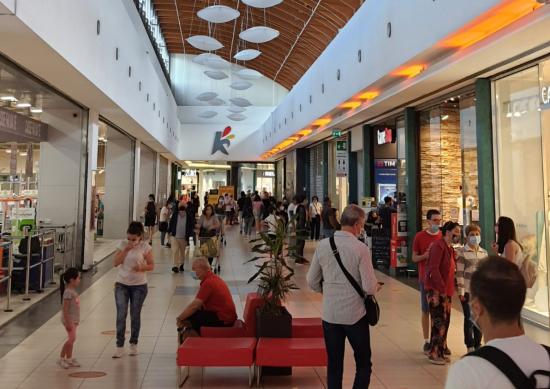New consumer trends post-lockdown

The gradual easing of restrictions post-lockdown has brought shopping centers back to life. Footfalls, however, vary depending on the geographic area. Retailers’ revenues also vary based on the type of business.
Is there going to be structural shift in consumer behavior? How is IGD responding to the new needs?
We asked Roberto Zoia, IGD’s Director of Asset Management, Development and Network Management.
What has changed in IGD’s shopping centers with the gradual easing of the restrictions imposed by the Italian government to limit contagion?
As of 18 May there has been an increase in the number of visitors at our shopping centers. To date we are at about 80% of pre-lockdown footfalls: a figure which is more than understandable if we consider that currently none of the events designed to stimulate traffic are underway. The decline in disposable income of certain groups of the population and the Italian families’ increased propensity to save in an environment of persistent uncertainty should also be taken into account. A decline of 20% in the footfalls at out Italian properties, therefore, is not disappointing. When looking at the drop in footfalls of around 15% in July, we must also take into account the different timing of promotional sales which began 1 August this year instead of the usual 1 July. The difference in the markdown period limits, in part, the significance of the traffic reported recently at our centers.
Overall, therefore, how is the trend in footfalls at the Italian portfolio seen?
The performance is not unsatisfactory, particularly if we consider that based on the most recent figure available at the end of June, tenants’ sales were down 13.6%, much less than the footfalls which were down by around 20%. If you want to make a more complete assessment, in addition to the average figure, you need to also look carefully at the performances by geographic area and merchandise.
Is the change in footfalls a regional phenomenon?
Without a doubt. In the northwest and in Emilia-Romagna, for example, the recovery is more difficult: the way people are behaving reflects the greater intensity with which Covid-19 struck the area. In Rome and Sicily, however, people have begun to behave like before. In Guidonia, to cite one concrete example, there have been days recently in which footfalls were 20% higher than on the same day in 2019. In order to plan promotional initiatives and events that draw in customers, it is important, therefore, to have a good understanding of the local reality.
I’ve always believed that in order to do our job of running shopping centers well, we need to take the local reality into account; the virus provided further proof that there are no standard recipes that can be applied across the board.
Is this ability to understand the territory, therefore, one of your strengths?
IGD can provide value added exactly in this role, as the interpreter of the specific needs of customers based on the individual area. Toward this end, at the end of the most severe phase of the lockdown, we conducted two surveys of roughly 7,000 visitors in seven of our most important shopping centers: the first between 13 and 18 May, the second between 3 and 9 June. The results confirmed the deep appreciation that the participants have for the attention that IGD paid to protecting people’s health. We also learned about expectations for the future with regard, for example, to the introduction of new brands in the malls which indicates that people have wants once again and are looking ahead.
Are there differences in the distribution of footfalls during the week?
Yes, and also quite pronounced. While before Saturday and Sunday were the busiest days, now they are the two hardest days. Finally, able to move freely between regions once again, a lot of people are going to vacation spots and second homes over the weekend which has caused a noticeable decline in the footfalls in shopping centers located near large cities. We trust, however, that this will change as people return in the month of September.
How have the retailers in your centers acted during this reopening phase?
The big international retail chains have set, centralized protocols which must be complied with which sometimes result in long lines of people waiting outside stores to have their temperatures taken after having just had it taken at the shopping center entrance. We have seen midsize retailers or franchisees, who have greater autonomy and ability to adapt to new situations, implement effective initiatives. In the last few weeks we have, moreover, seen new openings by brands that have confirmed their interest in being in our shopping centers. We believe that the closing of these new leases is an important sign.
You told us before that in addition to performances which vary based on the geographic location of the center, there are also differences based on the type of merchandise …
Yes, that’s correct. If, on the one hand, electronics have been posting the best sales – given the need to make sure that all family members have the devices they need to study and work remotely – clothing is the sector that is suffering the most, particularly women’s clothing. Part of the problem is that a few brands are still benefitting from government relief programs and employees are not back on the job, yet. The workforce, consequently, is limited: the efficiency that existed before in the stores is, in fact, lacking at a time when more workers are needed to rapidly sanitize each garment tried on.
A few brands tested the dark store format for a few days, with access via a “click&collect” service, but then returned to the traditional model as customers still want to see and try on the garment before buying it.
How are food&beverage locations functioning?
All the coffee bars in our shopping centers have reopened, even if demand for restaurants is still limited. The demand for restaurants is still limited so a few have preferred to remain closed for the moment. You need to bear in mind that the shopping centers, which used to be able to count on people working in the area at lunchtime, are being penalized today as many have yet to return to the office and are still working remotely. There’s a whole world of teachers, pharmaceutical sales representatives or employees of maintenance companies who used to have lunch at the shopping center which have yet to resume their normal routines. Many employers are actually giving longer lunch breaks so employees can go home for lunch and come back to work in the afternoon.
How are the hypermarkets doing?
The hypermarkets represented a lifeline during the most severe phase of the lockdown, guaranteeing the supply of essential goods which allowed us to keep our shopping centers open at all times. It seems that they are regaining a certain appeal, including in the eyes of those who, up until a few months ago, looked at them with a degree of skepticism. After 18 May sales volumes naturally fell due to an increase in spending at bars and restaurants: the erosion of the peak in food consumption recorded when all Italians were at home on lockdown was, moreover, expected and has affected not only IGD’s centers, but the sector as a whole.
Cinemas were able to reopen only as of 15 June: how’s it going?
It’s true, as of 15 June legislation made it possible to go to the movies again. The tenants that operate the cinemas, however, decided to postpone the reopening to mid-August and the beginning of September, due to the lack of new films as the production companies suspended the filming of new movies: it will take some time, therefore, for things to get back to normal. In the meantime, at the shopping center in Mantua we launched an outdoor cinema initiative at the Arena La Favorita, where we showed the movies that came out just before the lockdown. It’s clear that until the cinemas have resumed, evening dining will also continue to be penalized.
How do you see the future of the shopping centers you are managing, then?
I believe that we shouldn’t let ourselves be influenced by the studies that call for a future in which we will continue to work from home, eat food that is delivered, buy everything we need online and that we will only watch movies in streaming on our televisions. The number of people who went to holiday spots in the last few weekends, filling up beaches, hotels and restaurants, shows that the fear of contagion has not changed people’s desire to go out and socialize.
In the future a few specific habits could change, but nothing indicates that there will be a substantive, permanent change in people’s life styles.
What scenario do you think is the most credible?
If we look at the statements of the WHO, it seems that we should get ready to see the worst in the fall. We have read a lot of studies of companies specialized in forecasting, but there are still no clear ideas about what projects should be undertaken.
In the short-term I believe that the priority is to know how to live with the emergency, also because in Italy a series of restrictions will still be in effect through 15 October.
In IGD we have decided that, regardless of how the contagion spreads, we will maintain a high level of supervision, social distancing and sanitization through the end of the year in order to guarantee the safety of everyone who enters our shopping centers. Naturally, we hope the restrictions will gradually be eliminated in order to make entering and being in the center easier, albeit without reducing the precautionary measures. The surveys we conducted of the 7,000 customers provided us with clear feedback in this regard. The key question that the visitor asks us is: “But you, IGD, are you able to effectively control distancing and provide me with a safe path to follow inside the center?”.
Yes, we are able to offer these guarantees. We will, therefore, continue to listen to the wishes of our customers, in order to provide concrete answers.
Thanks and buon lavoro.
Share




